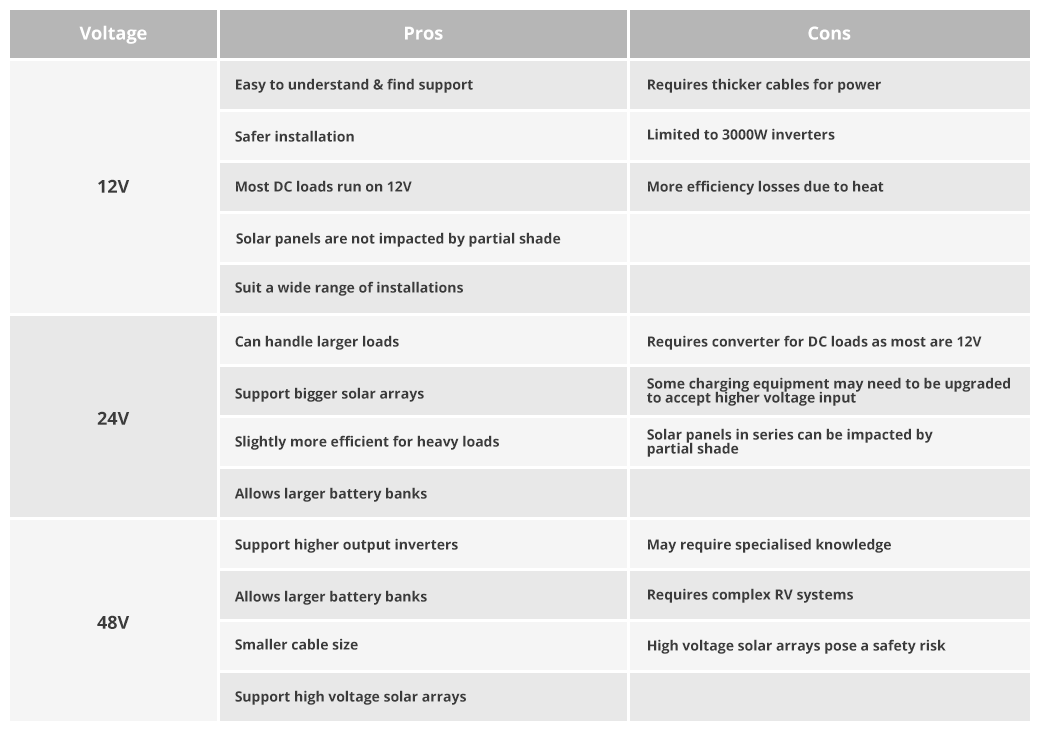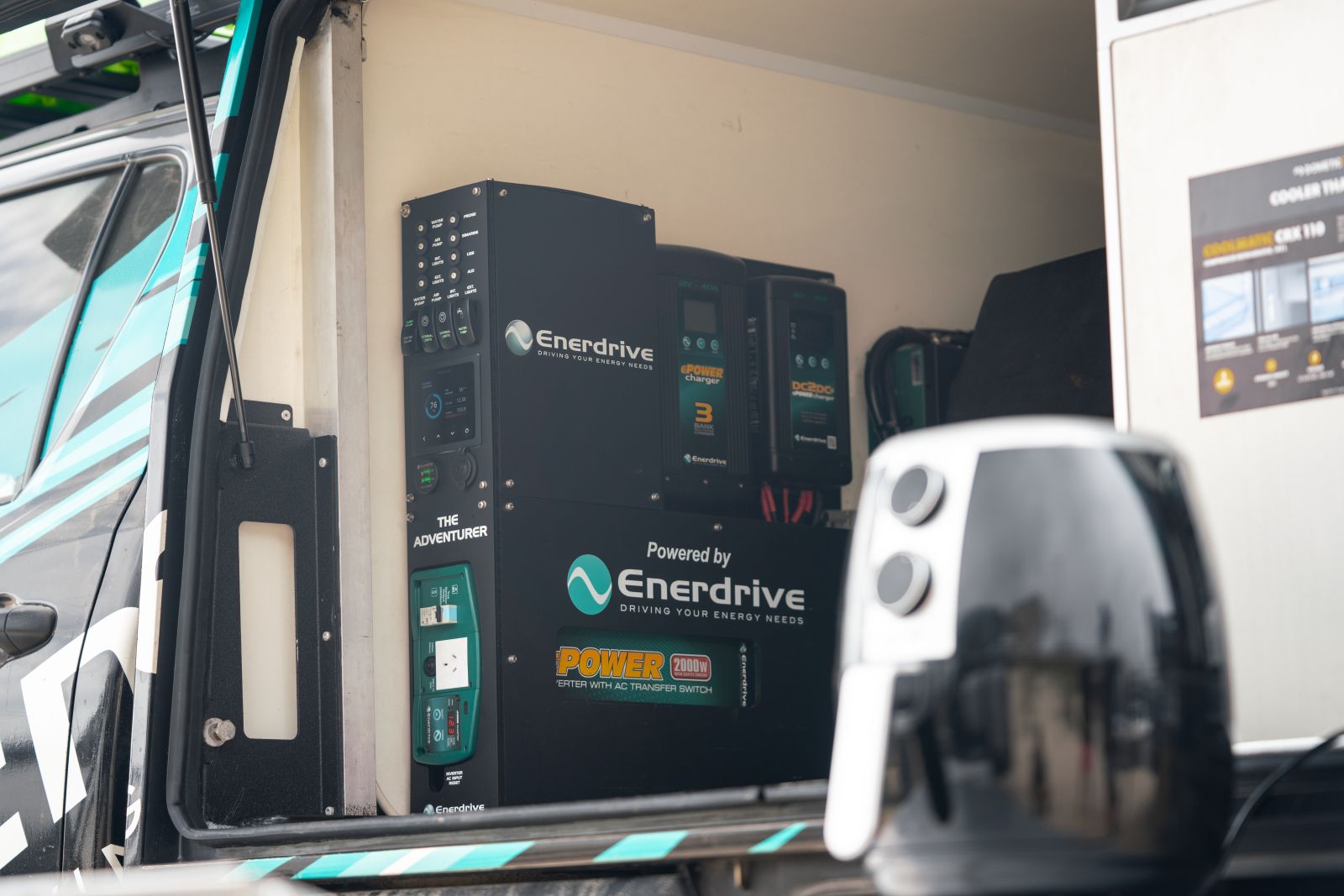We know that navigating the world of caravan electricity and off-grid power systems for your caravan can be a bit like deciphering a secret code. So we're here to break it down for you in a simple and straightforward way.
Understanding Nominal Voltage
Let's start with the basics. When we talk about a 12V system, we're referring to the nominal voltage of the battery bank, which is typically 12V. The actual voltage you'll see on your voltmeter can vary between 10V and 14.6V, depending on the state of charge, battery chemistry and other variables.
For simplicity, these are often referred to as "12V Batteries." This nomenclature is replicated as you move through 24V (25.6V lithium) and 48V (51.2V lithium) battery banks.
Making the Right Decision
When it comes to choosing the best caravan electricity and system voltage, we recommend starting with 12V unless you have specific reasons why it wouldn't work for you. Then, consider 24V, and only explore 48V if your system requirements are truly unique. Opting for an inappropriate voltage can lead to unnecessary costs, complexity, and limited expansion options down the road.
As a general guide most systems that require an inverter output requirement that doesn't exceed 3000W, opting for a 12V/24V is recommended. But in most cases, customers are still happy to remain in a 12V system.
One of the driving forces behind an increase to 48V is the advantage of thinner cabling. As voltage increases, current decreases. The lower the current, the lighter the cable can be used. This leads to weight and cost savings in large off-grid installs. A cooler caravan electricity system also leads to fewer losses as energy loss happens in the form of heat, generated by current.
The introduction of coffee machines, air fryers and induction cooktops into the caravan world has led to an increase demand in 240V AC power. 48V systems, coupled with large solar arrays could be the future for stable supply to these appliances without the reliance on back up generators and alternator charging. However, at this stage it’s still a niche application. The vast majority of our customers are looking for a 12V solution.
Solar Voltages
Let’s look at some other pros and cons between 12V/24V and 48V.
Firstly the same nominal naming is present when discussing solar voltages. We call it a 12V panel, but realistically, the open circuit voltage of the panel can be over 20V, and over 40V for what we call a 24V panel.
To provide charge to a high voltage system, the solar panel array voltage needs to be increased, this is somewhat of a double-edge sword. Panels are connected in series to achieve this. A 48V system needs around 80V Open Circuit Voltage of the solar panel string. On one hand we gain efficiency and drop cable weight, but conversely, panels connected in series can be subjected to lower output when partially shaded. Shade on one panel will impact the entire strings output. Something that panels in parallel don’t suffer from.
Safety also needs to be factored in when dealing with high voltage systems. An 80V solar array is dangerous and needs to be taken in consideration for anyone doing electrical work on the panels and system. We see 80% of mobile customers choose a 12V solar array, with the remainder looking at a 24V system as their need for solar recharge is so high, that they need to keep the current a bit lower.
48V is still quite new in caravan electricity but has been in the home off-grid market for many years and continues to gain momentum for that application. As there is no charging from alternator, the off-grid home systems can afford to up their battery voltage and increase efficiency. Shading is also less of an issue as shaded areas are known and planned for during solar installation of roof or ground.
Pros and Cons of 12V, 24V & 48V Caravan Electricity

Here at Caravan RV Camping, we stock a range of bundles to help make picking the perfect caravan electricity system a breeze.
In summary, Lithium 12V batteries have evolved to allow for high continuous discharge currents. These high currents are crucial for powering high wattage inverters that are connected to air conditioners, coffee machines, etc.
We’re more than happy to recommend a large 12V system with appropriate charging equipment. We might look at a higher voltage solar array as charge currents becoming too high for solar controller inputs and cables can’t handle the current.
Most systems would have multiple 12V solar panels all in parallel on the roof, or multiple 24V solar panels connected int the same way. It’s rare our customers are choosing series connection on the roof.
Still unsure about the right voltage for your caravan's solar power system? Don't worry; we're here to help you figure it out. Just reach out to us at 1800 787 278, and we'll assist you in selecting the perfect power solution for your needs.
-
DISCLAIMER* Please note, this advice is general in nature and we strongly recommend consulting the product manual and where relevant, a professional installer.



.jpg)




